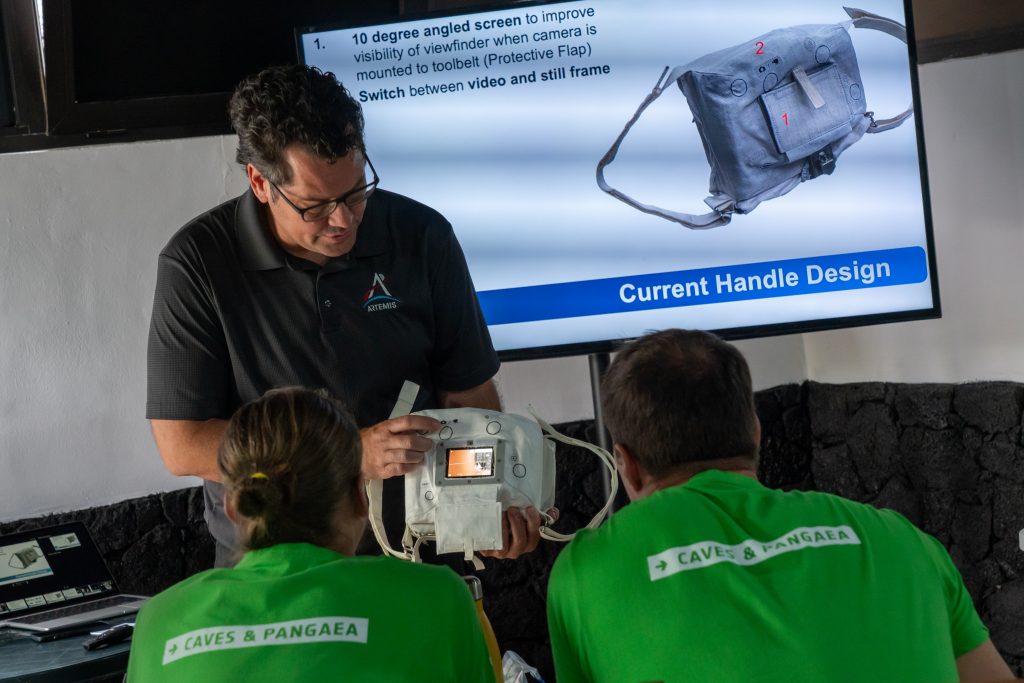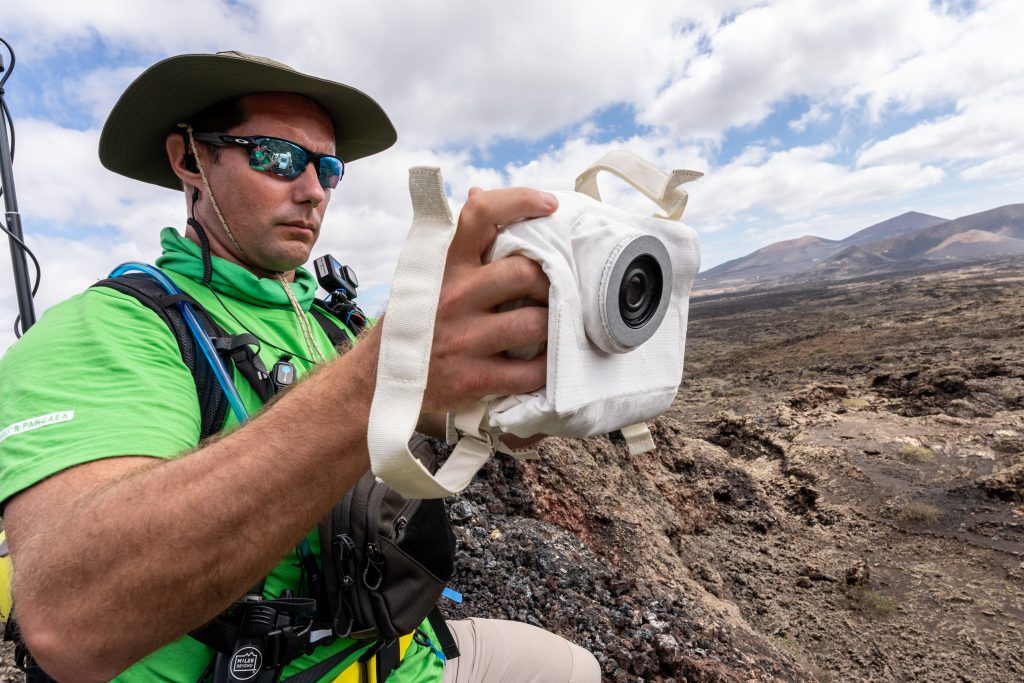To develop the best camera for the job, European astronauts and scientists are lending a helping hand to NASA’s Artemis imagery team.
The engineers behind the Handheld Universal Lunar Camera (HULC) worked with ESA in the lunar-like landscapes of Lanzarote, Spain, to put the new camera through its paces during the PANGAEA training programme.
PANGAEA prepares astronauts to become effective field scientists for future missions to the Moon. The programme saw an international crew testing the capabilities of the camera in realistic scenarios for geological exploration.

During the geological field trips astronauts document their exploration work using the ESA Electronic Field Book – a tool that allows PANGAEA’s geology instructors to follow and support the crew from the science room. This year, the science team received live audio and video in real time.
“Adding the Moon camera allowed the crew to have a realistic taste of lunar surface exploration. It was a great enhancement of their experience, something we’d be happy to repeat in future editions,” says Loredana Bessone, PANGAEA’s Project Lead.
A new camera for the Moon
The new lunar camera is built from professional off-the-shelf cameras with great sensitivity to light and state-of-the-art lenses. To prepare it for space, the NASA team made several modifications, including adding a blanket for dust and thermal protection – temperatures range from minus 200 to 120 degrees Celsius on the Moon – as well as a new set of ergonomic buttons for astronauts wearing gloves in bulky spacesuits.

One of the most prolific European photographers in orbit, ESA astronaut Thomas Pesquet, praised the design after using it at PANGAEA. “The engineers have done a really good job reconfiguring the buttons and arranging them in a simple yet reliable protection for the camera,” he says.
Capturing images will be key for documenting scientific discoveries during future Moon missions. One objective during PANGAEA was to select the most suitable lenses.
Thomas Pesquet, NASA astronaut candidate Jessica Wittner and Takuya Onishi from the Japanese space agency used the camera in broad daylight, but also in the darkness of volcanic caves to simulate extreme conditions for lunar photography.

“The lunar camera will be one of many tools they will need to handle on the Moon, so it should be easy to use. The human factor is a big deal for us, because you want the camera to be intuitive and not taxing on the crew,” explains Jeremy Myers, NASA’s lead for the HULC camera.
Together with some of Europe’s best planetary scientists, Jeremy reviewed the quality of the images. “It was very useful to have the geologists’ point of view to make sure the photos had the right resolution, depth of field and exposure to maximise the science results,” he adds.
A quantum leap from the Apollo era
Astronauts of the Apollo 11 mission took iconic images of the Moon with a very different camera – a standalone, mechanical Hasselblad camera with a 60 mm lens. During the entire mission, the astronauts collected 1407 photos from four of these cameras.

The Artemis Moon camera will be the first mirrorless camera for handheld use in space. Mirrorless cameras provide excellent image quality in low light situations, making it well suited to the challenging high contrast environment of the Moon.
The camera will also record videos. Videos can provide situational awareness to the ground teams and help document the exploration of our nearest cosmic neighbour.
Lights, camera, action!
Thomas took over 380 000 pictures in space during his two missions to the International Space Station. “I spent a lot of time learning what you can do with the cameras available in orbit. It is not just point and shoot. On the Moon, just pressing the buttons in auto mode won’t be good enough,” he explains.

The Artemis III mission will land on the South Pole of the Moon, close to permanently shadowed craters where the crew will look for evidence of water ice. “Conditions for photography will be tricky in many ways, from operating the camera with the gloves on, to very low light levels and big contrast between bright and dark sources,” adds Thomas.
The future moonwalkers will take a variety of shots on the lunar surface, from close-up to panoramic images and videos. Jeremy spent a week with the PANGAEA crew closely following the camera’s performance in the hands of the astronauts.

“We are trying to choose the best lenses for the Moon shots and optimise the settings in a smart way. We want astronauts to be able to take a detailed image of a crystalline structure in a rock and to capture landscapes, all with the right exposure,” explains Jeremy.
The testing continues
While the core of the camera remains the same, the interface and housing keep evolving. One version will fly to the International Space Station for additional testing in the near future.
NASA teams have done extensive testing for the three major challenges of space: thermal, vacuum and radiation effects. On the Moon, one added challenge will be the abrasive nature of lunar dust. Last year, the camera was part of simulated moonwalk with the JETT 3 mission in Arizona, USA.

Some European career astronauts recently had the opportunity to handle the camera during an imagery meeting in the Netherlands, and ESA astronauts Matthias Maurer and Alexander Gerst tested its features at the European Astronaut Centre in Germany.
“We will continue modifying the camera as we move towards the Artemis III lunar landing,” says Jeremy. “I am positive that we will end up with the best product – a camera that will capture Moon pictures for humankind, used by crews from many countries and for many years to come,” he concludes.

Discussion: 3 comments
Hi friends! Great story. I confess to a geeky curiousity about the reference to the “Harrison Schmidt 60 mm lens,” and wonder if there might be some confusion with Apollo 17 astronaut Harrison Schmitt? As an old guy who watched the first Apollo landing and became a lifetime spaceflight geek and aerospace engineer, and especially a commercial photographer, this is the first time I’ve come across that reference.
NASA’s reference notes the use of a 60mm Zeiss Biogon lens, the typical name for that lens:
https://www.nasa.gov/wp-content/uploads/static/history/alsj/Biogon5.6_60mm_ZEISS.pdf
Hassalblad’s reference is also to the Zeiss 60mm Biogon:
https://www.hasselblad.com/about/history/hasselblad-in-space/
Finally, Andy Saunders’ REMARKABLE new book “Apollo Remastered: The Ultimate Photographic Record” (Get it!) also refers to a “Zeiss Biogon 60mm f/5.6 custom designed for use on the lunar surface with the Hasselblad Electric Data Camera (HDC).” Andy spent years working with NASA unfreezing the film of the day, scanning it, and preparing the book for publication, and I sense has a pretty good understanding of lunar photography.
Anyway, thanks for letting me go DEEPLY down this rabbit hole, and if there was a Harrison Schmidt lens I’d love to know more about it. 🙂
Dear Rich, thanks for flagging this. You are right! That mention to Harrison Schmitt somehow slipped into the text – you can blame the editors ?. It is now corrected. We are grateful to people like you who actually read carefully and take the time to do some research.
Most welcome! I saw this story copied on another site and noted the t-shirts with “CAVES & PANGAEA” on the back. Was so intrigued that I found my way I’m here, and will be a regular reader – cheers!